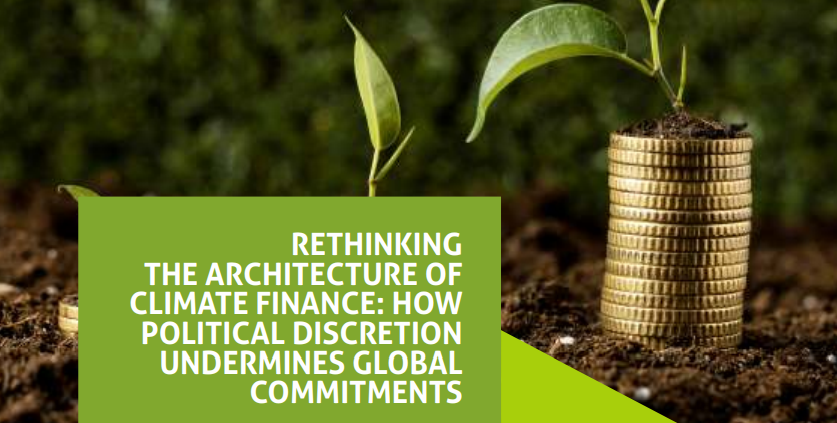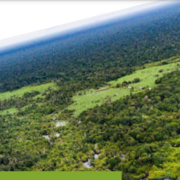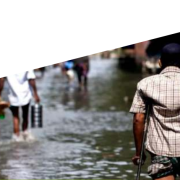Rethinking the Architecture of Climate Finance: How Political Discretion Undermines Global Commitments
The global climate finance target for developing countries has tripled from $100 billion to $300 billion per year by 2035 (United Nations Climate Change, 2024). This target did not emerge without reason. Out of 168 NDCs submitted as of 9 September 2024, 91% of countries stated that finance is a crucial component in the implementation of their climate targets. Of that number, 69% said they require international financial assistance (United Nations Climate Change, 2024). Yet, past experience shows that setting a number does not guarantee timely achievement. The previous target, which was expected to be reached by 2020, was only realized in 2022 when developed countries mobilized $115.9 billion (OECD, 2024). The problem lies not merely in the fiscal capacity of donor countries, but in an institutional framework that is weak and overly reliant on the political preferences of incumbent leaders in donor countries. When the system is driven by political considerations, uncertainty over the realization of climate finance targets becomes inevitable.
The climate finance structure under the UNFCCC was indeed designed as a soft law in order to be inclusive and encourage broad participation. The Paris Agreement only urges developed countries to provide financial support, without setting a minimum contribution amount or a clear distribution of responsibilities among donor countries. The compliance committee that was established is non-confrontational and non-punitive, relying solely on public pressure and criticism to push countries toward compliance (Nugrahanti & Martinez-Caro, 2024). It is therefore unsurprising that the current mechanisms, including the reporting obligations under the transparency framework, are insufficient to influence donor behavior and often risk becoming a mere formality. In the absence of binding obligations, donor countries are free to decide how much they contribute, even though fair share benchmarks exist as a basis for expectation and comparison. In 2020, over two-thirds of developed countries failed to deliver their fair share of the $100 billion climate finance goal. Major shortfalls came from Australia, Canada, Italy, and Spain, with each contributing less than one-third of their fair share (Colenbrander, Pettinotti, & Cao, 2022).
The amount of climate finance provided by donor countries ultimately depends entirely on their national budget policies, shaped by domestic political support (Pickering & Mitchell, 2017). In practice, it is political leaders who hold the power to translate that support into concrete decisions, including decision about how much they are willing to contribute. Each leader brings different values and perceptions of the climate crisis, which directly influence whether climate becomes a policy priority. Amid economic stagnation and rising geopolitical tensions, political leaders in donor countries can shift their focus and resources toward other concerns, such as energy security, inflation control, or national defense. Climate issues, as a result, are increasingly being sidelined. In fact, even within the frameworks of both the UNFCCC and the G20, countries like Australia, Brazil, Saudi Arabia, Russia, and the US have at times actively worked against global efforts to combat the climate crisis, as their leaders prioritized the interests of the fossil fuel industry (Petz, 2022).
One political leader who appears less committed to climate issues is Donald Trump. He repeatedly expressed skepticism about the climate crisis, describing global warming as a hoax created by China to weaken the US economy and equating climate change with an expensive tax that benefits a select few (Campbell, 2016). As someone with a business background, it is hardly surprising that environmental issues are not his top priority. The ways in which political leaders make decisions and set priorities in their personal lives often translate into their political lives as well (Burden, 2007). Hence, Trump does not perceive climate change as an environmental concern, but rather approaches it primarily as an economic issue.
This is then reflected in the OECD data on US climate-related ODA from 2012 to 2022. During Trump’s first administration, the US contributions to climate finance dropped significantly compared to those during Barack Obama’s presidency. When Joe Biden took office, climate finance commitments rose significantly once again (OECD, 2022). However, when Trump returned to office in 2025, the direction of climate finance seemed to change again. On his first day at the White House, he signed executive orders withdrawing the US from the Paris Agreement and shutting down USAID operations (Kates, Rouw, & Oum, 2025). This is extremely unfortunate, as the US is cumulatively the largest source of greenhouse gas emissions since the 1850s and remains the second-largest annual emitter. Coupled with its position as the world’s largest economy, the US should bear the greatest responsibility for climate finance (Zou, Alayza, Higgins, & Larsen, 2024).
The shutdown of USAID has impacted dozens of countries, including Colombia, Mozambique, Bangladesh, and Fiji. USAID climate projects in these countries got cancelled, preventing governments from preparing for extreme weather, responding effectively when disasters strike, or strengthening agricultural practices to maintain food supplies during droughts, floods, and other climate-related disruptions (Schonhardt, 2025). The US also pulled out of the Just Energy Transition Partnerships (JETP) in South Africa and Indonesia. Although other members of the International Partners Group (IPG) expressed continued commitment to the projects, the US exit left a significant financing gap (Tamasiga, 2025), raising uncertainty about who will step in to fill it. Without a clear replacement, progress on the energy transition could slow down or face delays.
Another example of leadership-driven climate finance fluctuation is Australia. When Prime Minister Scott Morrison took office in 2018, he withdrew from the GCF, saying he no longer wanted to “throw money into some global climate fund.” This contrasted with the previous government under Tony Abbott, which contributed around $50 million annually to the GCF between 2015 and 2018. During Abbott’s tenure, GCF project approvals averaged $100 million a year. At that time, Australia was GCF member and co-chair, and it helped mobilize more global funding through advocacy. Each dollar Australia contributed unlocked an additional $1.60 for the Pacific. Following Morrison’s withdrawal, approvals dropped to about $46 million annually (Hammersley, Pill, & Rajah, 2023).
In February 2025, Prime Minister Keir Starmer announced a reduction of the UK aid budget from 0.5% to 0.3% of national income to increase defense spending to 2.5% of GDP by 2027. The UK’s climate finance commitment is drawn from this aid budget. Previously, the UK had pledged to allocate $14.7 billion in climate finance to developing countries between 2021 and 2026, with more than half of the funds expected to be disbursed in the final two years of the pledge. The aid budget cut has therefore cast uncertainty over whether this commitment can be fulfilled. A similar trend has emerged across Europe. Germany, Sweden, France, Belgium, and the Netherlands have all implemented significant cuts to their overseas aid budgets due to shifting interest priorities (Farand, 2025). Inconsistencies in climate finance make it hard for recipient countries to strategize effectively. The inherent volatility complicates the planning of their long-term projects for both mitigation and adaptation (Nor & Mohamed, 2024)
The existing climate finance architecture is too loose, leaving too much room for political discretion. Donor countries can easily withdraw or cut climate funding, especially during political transitions, with no consequences to deter such actions, as seen in the cases of the US, Australia, and the UK. The architecture operates as if it were built on goodwill alone, centered around pledges but lacking concrete mechanisms to ensure accountability. This makes the flow of climate finance unpredictable, jeopardizing climate projects in developing countries, which in turn puts the ambitious $300 billion per year target at risk. After all, the target is not just about numbers. It is meant to represent real support from developed to developing countries. The target is only as strong as the climate projects that underpin it. When those projects are uncertain, so is the achievement of the target. Failing to meet the target would result in devastating impacts for the world’s most climate-vulnerable nations.
The world can no longer rely on the same system. Institutional reform is urgently needed to establish a climate finance framework that is more enforceable and backed by robust regulatory and oversight mechanisms. This framework must be resilient to political shifts and changes in leadership, ensuring donor countries deliver on their promises. Only through this transformation can climate finance become truly reliable, sustainable, and equitable.
References
Burden, B. C. (2007). Personal Roots of Representation. Princeton: Princeton University Press.
Campbell, C. (2016). TRUMP: I was joking when I said the Chinese ‘created’ the concept of climate change. Retrieved from Business Insider: https://www.businessinsider.com/donald-trump-china-created-climate-change-2016-1
Colenbrander, S., Pettinotti, L., & Cao, Y. (2022). A fair share of climate finance? An appraisal of past performance, future pledges and prospective contributors. London: ODI.
Farand, C. (2025). UK aid budget cuts threaten climate finance pledge to vulnerable nations, expert warn. Retrieved from Climate Home News: https://www.climatechangenews.com/2025/02/25/uk-aid-budget-cuts-threaten-climate-finance-pledge-to-vulnerable-nations-experts-warn/
Hammersley, G., Pill, M., & Rajah, R. (2023). Revitalising the Green Climate Fund. Retrieved from Lowy Institute: https://www.lowyinstitute.org/publications/revitalising-green-climate-fund
Kates, J., Rouw, A., & Oum, S. (2025). U.S. Foreign Aid Freeze & Dissolution of USAID: Timeline of Events. Retrieved from KFF: https://www.kff.org/u-s-foreign-aid-freeze-dissolution-of-usaid-timeline-of-events/
Nor, M. I., & Mohamed, A. A. (2024). Investigating the complex landscape of climate finance in least developed countries (LDCs). Discover Environment, 1-22.
Nugrahanti, I., & Martinez-Caro, A. O. (2024). Ambiguity To Accountability: Climate Finance From An International Law Perspective. Retrieved from The Contrapuntal: https://thecontrapuntal.com/cop28-climate-finance-law/
OECD. (2022). Donor Perspective. Retrieved from OECD: https://webfs.oecd.org/climate/DonorPerspective/
OECD. (2024). Developed countries materially surpassed their USD 100 billion climate finance commitment in 2022. Retrieved from OECD: https://www.oecd.org/en/about/news/press-releases/2024/05/developed-countries-materially-surpassed-their-usd-100-billion-climate-finance-commitment-in-2022-oecd.html
Petz, D. (2022). G20 – Malakelola Kebijakan Iklim untuk Planet yang Malang? In P. S. Winanti, & W. Mas’udi, G20 Di Tengah Perubahan Besar: Momentum Kepemimpinan Global Indonesia? (pp. 157-169). Yogyakarta: Gadjah Mada University Press.
Pickering, J., & Mitchell, P. (2017). What drives national support for multilateral climate finance? International and domestic influences on Australia’s shifting stance. International Environmental Agreements: Politics, Law and Economics, 107-125.
Schonhardt, S. (2025). Trump killed US climate aid. Here’s what it means for the world. Retrieved from E&ENews: https://www.eenews.net/articles/trump-killed-us-climate-aid-heres-what-it-means-for-the-world/
Tamasiga, P. (2025). Debating Trump 2.0 and Implications for Africa – How the United States Trigger a Global Shake-Up in Climate Finance. Retrieved from Stiftung Wissenschaft und Politik : https://www.swp-berlin.org/publikation/mta-spotlight-53-debating-trump-20-and-implications-for-africa-a-global-shake-up-in-climate-finance
United Nations Climate Change. (2024). 2024 NDC Synthesis Report. Retrieved from United Nations Climate Change: https://unfccc.int/process-and-meetings/the-paris-agreement/nationally-determined-contributions-ndcs/2024-ndc-synthesis-report
United Nations Climate Change. (2024). COP29 UN Climate Conference Agrees to Triple Finance to Developing Countries, Protecting Lives and Livelihoods. Retrieved from United Nations Climate Change: https://unfccc.int/news/cop29-un-climate-conference-agrees-to-triple-finance-to-developing-countries-protecting-lives-and
Zou, C. Q., Alayza, N., Higgins, H., & Larsen, G. (2024). Which Countries Should Pay for International Climate Finance. Retrieved from World Resources Institute: https://www.wri.org/insights/international-climate-finance-which-countries-should-pay
.










Leave a Reply
Want to join the discussion?Feel free to contribute!